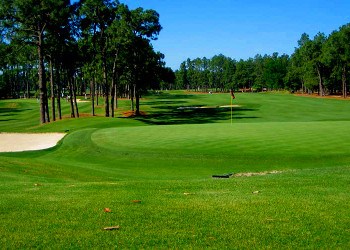
A crowned green, also known as a turtleback green, is a golf term that refers to a specific type of green design commonly found on golf courses. It describes a green with a distinct domed or convex shape, resembling the shell of a turtle. The center of the green is higher than the surrounding areas, creating a challenging playing surface for golfers.
Here are a few key points about crowned greens in golf:
- Shape and Slope: A crowned green has a noticeable convex shape, with the highest point located in the center of the green. From the center, the green slopes down towards the edges, often featuring severe slopes and undulations. This design feature presents a challenge for golfers trying to hold the ball on the green and navigate the slopes effectively.
- Pin Placement: Due to the undulating nature of a crowned green, pin placements can be strategically positioned to add difficulty to the hole. Placing the pin on a slope or near the edges of the green can require precise approach shots and delicate putting to avoid rolling off the green or facing challenging downhill putts.
- Roll-off Areas: Crowned greens often have roll-off areas surrounding the edges, where shots that miss the green can roll away from the playing surface. These areas can present additional challenges for golfers, as it requires skill and accuracy to recover and get the ball back onto the green.
- Strategy and Shot Placement: Playing on a crowned green requires careful strategy and shot placement. Golfers need to consider the slope and contours of the green when selecting their approach shots to ensure the ball stays on the putting surface. Controlling the spin and trajectory of the ball becomes crucial in order to hold the green and avoid challenging downhill or sidehill putts.
- Historical Significance: Crowned greens have been a traditional design feature in golf course architecture for centuries. They were prevalent in early golf course designs and continue to be found on classic and historic courses. Playing on a crowned green adds to the challenge and charm of the golfing experience, reflecting the traditions and strategic elements of the game.
Crowned greens, or turtleback greens, are known for their distinct shape and challenging playing conditions. Golfers must navigate the slopes and undulations with precision and skill to successfully negotiate these greens. They add an element of strategy, excitement, and difficulty to the game, demanding thoughtful shot selection and precise execution from golfers.
A green that is highest in the center and falls away to the sides. Crowned greens are most common on courses built before World War II and were favored by architects including Donald Ross, designer of Pinehurst No. 2 in North Carolina.





